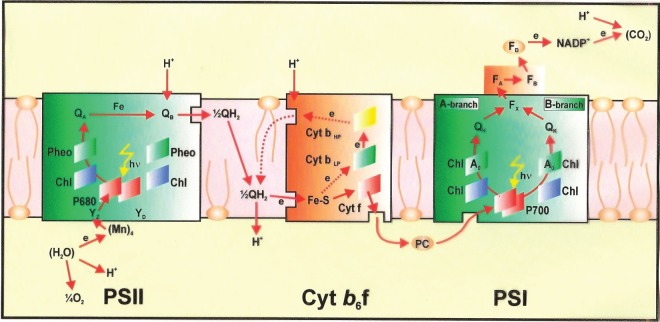Figure 3.
Schematic of the electron–proton transport chain of oxygenic photosynthesis in the thylakoid membrane, showing how photosystem I (PSI) and photosystem II (PSII) work together to use absorbed light to oxidize water and reduce NADP+, in an alternative representation to the Z-scheme shown in figure 2. The diagram also shows how the vectorial flow of electrons across the membrane generates a proton gradient which is used to power the conversion of ADP to ATP at the ATP synthase complex (CFoCF1) which is also embedded in the thylakoid membrane (not shown). In both PSI and PSII, the redox-active cofactors are arranged around a pseudo-twofold axis. In PSII, primary charge separation and subsequent electron flow occurs along one branch of the reaction centre. However, in the case of PSI, electron flow occurs up both branches as shown. Electron flow through the cytochrome b6 f complex also involves a cyclic process known as the Q cycle. YZ = tyrosine; P680 = primary electron donor of PSII composed of chlorophyll (Chl); Pheo = pheophytin; QA and QB = plastoquinone; Cyt b6f = cytochrome b6f complex, consisting of an Fe–S Rieske centre, cytochrome f (Cyt f), cytochrome b low- and high-potential forms (Cyt bLP and Cyt bHP), plastoquinone binding sites, Q1 and Q0; PC = plastocyanin; P700 = primary electron Chl donor of PSI; A0 = Chl; A1[Q] = phylloquinone; Fx, FA and FB = Fe–S centres, FD = ferredoxin; FNR = ferredoxin NADP reductase; NADP+ = oxidized nicotinamide adenine dinucleotide phosphate. YD = symmetrically related tyrosine to Yz but not directly involved in water oxidation, and QH2 = reduced plastoquinone (plastoquinol), which acts as a mobile electron/proton carrier from PSII to the cytochrome b6f complex. With the exception of the mobile electron carriers Q/QH2, PC and FD, the remaining redox-active cofactors are bound to multisubunit protein complexes that span the membrane depicted as coloured boxes.

